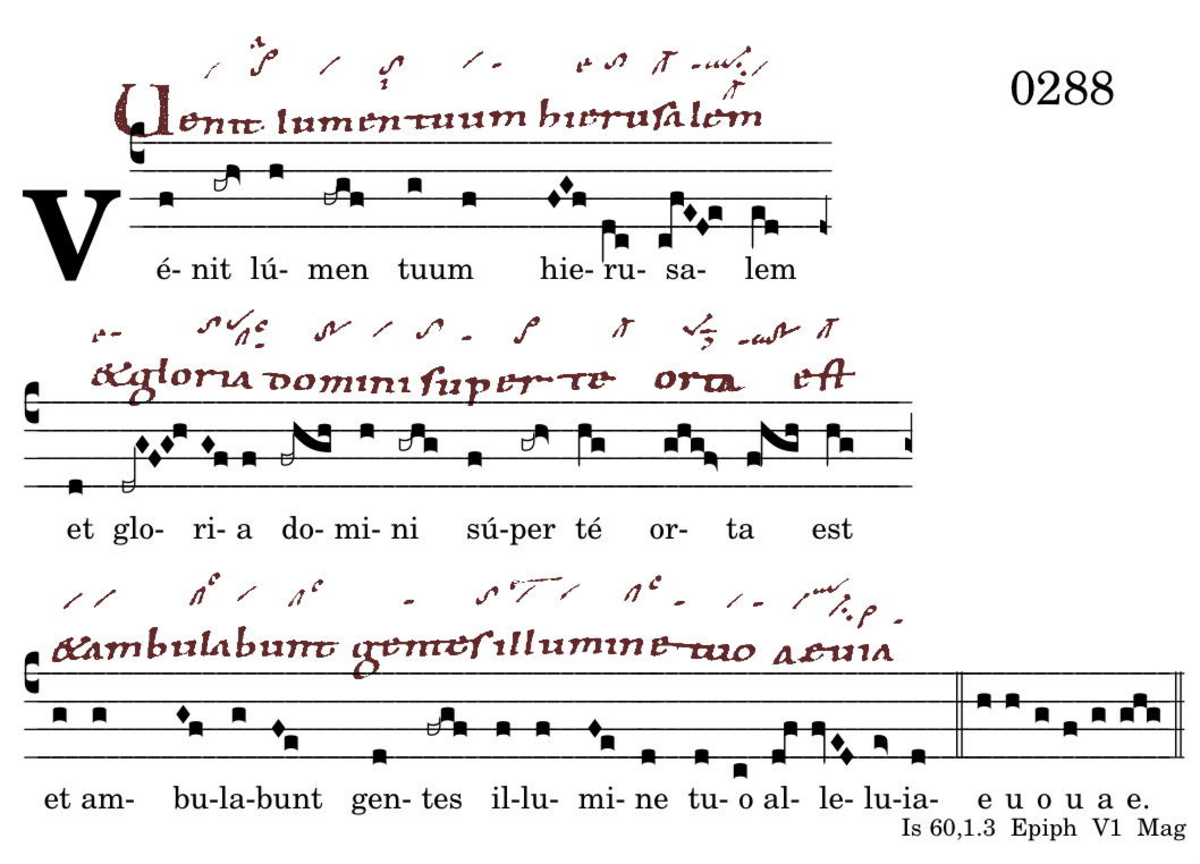🔘 IN GR TR AL OF CO xxxxx ✅ 2️⃣ 0️⃣ 3️⃣ 4️⃣ 5️⃣ 6️⃣ 7️⃣ 8️⃣ xxxxx AN RP IV alia
0288 AN Venit lumen tuumModus 1
FML alloq Die Formel kann sich nicht entscheiden, ob sie ein FML alloquium ist oder einen TrcPAR setzen soll. Sie tut beides, sowohl als auch. „Vénit lúmen“, beide Akzent sind betont, der Trc verliert durch die Liqueszenz seinen letzten Ton, damit ist er ein Pes. Sollten die beiden möglichen Akzente weder-noch betont sein, würde ein Epiphonus auf der Binnensilbe stehen. Das selbe Spiel wird abermals bei „súper té“ gespielt werden.
Nun macht die Antiphon einen Ausflug in das Melodiematerial der Responsorien:
RP1 D i Hauptakzent vorne (i = incipiens) „Vénit lúmen túum ierusalem“. Das wichtigste Wort „lumen“ ist nocheinmal durch den Wortartikulationstorculus (TrcFIN) bestätigt. So wichtig der Name „ierusalem“ ist, hier steht er trotz Akzenttorculus (kTrc) im Schatten.
1INC ad4 bleibt mit circulatio und der Vorwegnahme der CAD 7A aus den Responsorien ein hochgespannter Text.
FML alloq + clv_cop.
RP7 Af PPO. accentus finalis ist der Hauptakzent, so ergibt sich eine Kette von wichtigen Akzenten, die auf das Ende zustreben:
„et glória dómini súper té órta est“.
Bemerkenswert ist, dass für „super te orta est“ ein Cento des Periodenanfangs (RP7 A) verwendet wird.
1NOV typ sehr freie Variation.
2INC cad
2INC asc Die dritte Periode ist recht gewöhnlich komponiert.
Die drei Zeilen (Perioden) stehen bilden eine Art dreifachen Xiasmus
A - B Venit lumen tuum - ierusalem
B - A et gloria domini - super te orta est
A - B et ambulabunt gentes - illumine tuo
Die 2.Periode ist die emotional die höchgespannte, die 1.Periode steht ihr nur wenig nach. Die 3.Periode fällt dagegen ab.
● Es kommt dein Licht, Jerusalem,
und die Herrlichkeit des Herrn ist über dir aufgegangen,
ja, die Völker wandeln in deinem Licht, Halleluja.
● Your light is coming, Jerusalem,
and the glory of the Lord has risen upon you,
yes, the nations are walking in your light, alleluia.
FML alloq The formula cannot decide whether it is a FML alloquium or whether it should set a TrcPAR. It does both, both and. „Vénit lúmen“, both accents are emphasised, the Trc loses its last tone through the liquescence, making it a pes. If the two possible accents neither-nor are emphasised, there would be an epiphonus on the internal syllable. The same game will be played again with „súper té“.
Now the antiphon makes an excursion into the melodic material of the responsories:
RP1 D i Main accent in front (i = incipiens) „Vénit lúmen túum ierusalem“. The most important word „lumen“ is confirmed once again by the word articulation torculus (TrcFIN). As important as the name „ierusalem“ is, it is overshadowed here despite the accentual torculus (kTrc).
1INC ad4 remains a highly tense text with circulatio and the anticipation of CAD 7A from the responsories.
FML alloq + clv_cop.
RP7 Af PPO. accentus finalis is the main accent, resulting in a chain of important accents leading to the end:
„et glória dómini súper té órta est“.
It is noteworthy that a cento of the periodbeginning (RP7 A) is used for „super te orta est“.
1NOV typ very free variation.
2INC cad
2INC asc The third period is quite usually composed.
The three lines (periods) form a kind of triple xiasmus
A - B Venit lumen tuum - ierusalem
B - A et gloria domini - super te orta est\
A - B et ambulabunt gentes - illumine tuo\
The 2nd period is the most emotionally charged, the 1st period is only slightly inferior. The 3rd period, on the other hand, falls away.

